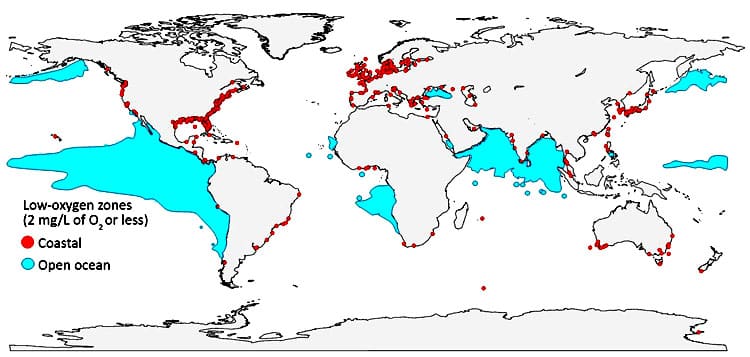Scientists call it the ‘deadly trio.’ If ocean acidification, oxygen loss, and overheating are not ended soon, a massive die-off of ocean life may be unstoppable.
In September 2020, Ian Angus published 3 articles in CLIMATE & CAPITALISM , an eco-socialist / ecological Marxist journal. The articles considered the elements of the deadly trio separately, but stressed the importance of understanding that they are closely related, have the same causes, and frequently reinforce each other.
We will be posting separate links to each of the 3 parts of the articles. Part 2 follows the General Introduction.
General Introduction.
“It is impossible to overstate the importance of the ocean to life on Earth. Covering 71% of the planet’s surface, it contains 97% of the world’s surface water and is central to the great biogeochemical cycles that define the biosphere and make life possible. Marine plants generate half of the world’s breathable oxygen.
The ocean’s metabolism — the constant flows and exchanges of energy and matter that have continued for hundreds of millions of years — is a vital part of the Earth System.
Most accounts of the relationship between the ocean and climate change focus on melting ice and rising sea levels, and indeed those are critical issues. At present rates, by 2100 the combination of global glacial melting and thermal water expansion will flood coastal areas where over 630 million people live today. Well over a billion people live in areas that will be hit by storm surges made bigger and more destructive by warmer seawater. Rapid action to slash greenhouse gas emissions would be fully justified even if rising seas were the only expected result of global warming.
Devastating as sea level rise will be, however, more serious long-term damage to the Earth System is being driven by what marine ecologists describe as the “deadly trio” of ocean warming, acidification and oxygen loss – deadly because when they have occurred together in the past, mass extinctions of animal and plant life have followed. “
Running Low on Oxygen – Part 2
“Since 1960, low-oxygen areas in the open ocean have expanded by 4.5 million square kilometres, an area the size of the European Union. Some regions have lost 40% of their oxygen, and the volume of water containing zero oxygen has more than quadrupled. The ocean is losing about a billion metric tons of oxygen every year. At present rates, the decline in life-giving ocean oxygen will triple by 2100. Add that to the rapidly growing number of coastal dead zones, and we have a life support emergency.
Overall, the ocean’s oxygen content has fallen just 2%, but the decline has occurred almost entirely in parts of the ocean where marine life is usually most abundant, so its impact is far greater than that percentage suggests.
This article focuses on a development that has only been studied in the past 15 years or so — the growth of hypoxic (low-oxygen) and anoxic (zero-oxygen) areas in the open ocean, caused by global warming.
All of the oxygen dissolved in seawater, no matter how deep, originated at or near the surface, in one of two processes.
- There is a constant exchange of oxygen molecules (O2) between the atmosphere and the ocean, at the air-sea interface. In simple terms, O2 from the air dissolves in the water and O2 from the water bubbles into the air.
- Considerably more O2 is produced by plants, especially phytoplankton, that grow on and in the water. Photosynthesis requires sunlight, and even in very clear water, light penetrates less than 200 meters down. That euphotic zone (euphotic is Greek for well-lit) is the origin of nearly half of the world’s oxygen, and most of the ocean’s supply.
In most of the ocean, the upper 200 meters or so is called the surface or mixed layer. Waves, wind-driven currents and convection constantly stir its contents, making its temperature, salinity and dissolved gas content roughly uniform. Dissolved oxygen spreads through the mixed layer relatively quickly and evenly.
Ocean deoxygenation results from greenhouse gases heating the world, and over 90% of that additional heat has been absorbed by the surface layer of the ocean, reducing the ocean’s total oxygen and expanding Oxygen Minimum Zones.
Three temperature-dependent processes — solubility, stratification and circulation, and aerobic metabolisms — are stealing the ocean’s breath.
[Extracts from: TRIPLE CRISIS IN THE ANTHROPOCENE OCEAN, PART 2]
READ FULL ARTICLE to better understand the impact of ocean deoxygenationation (loss of oxygen) – click this link to the whole article :

Leave a Reply
You must be logged in to post a comment.